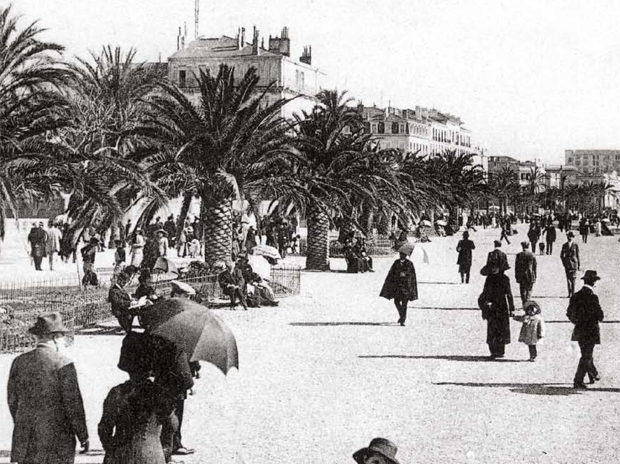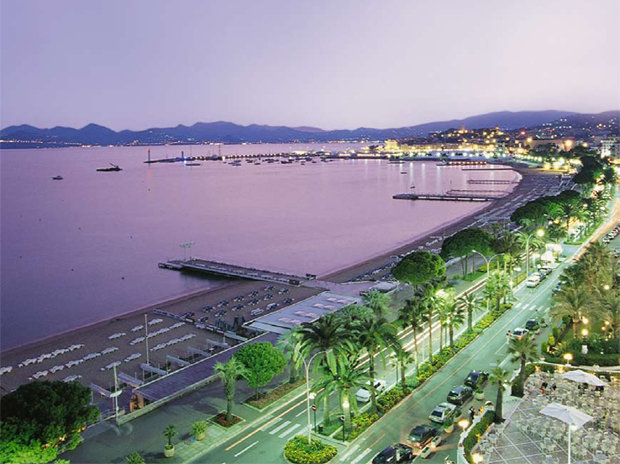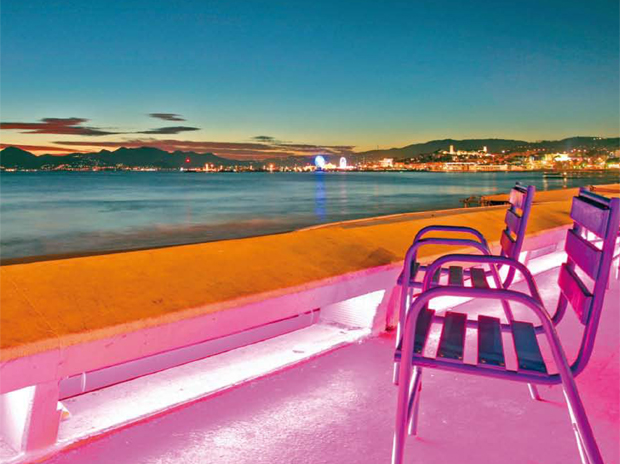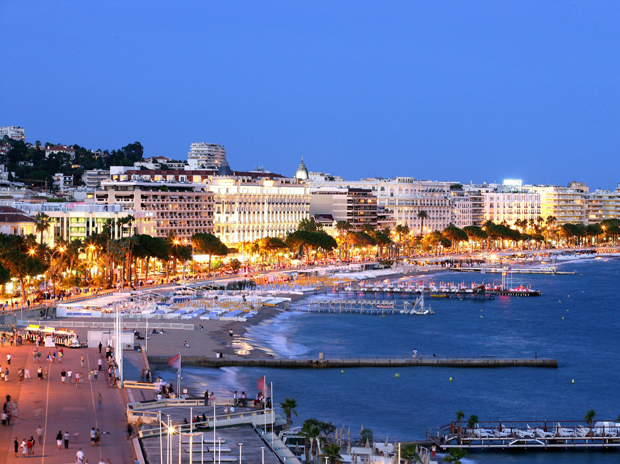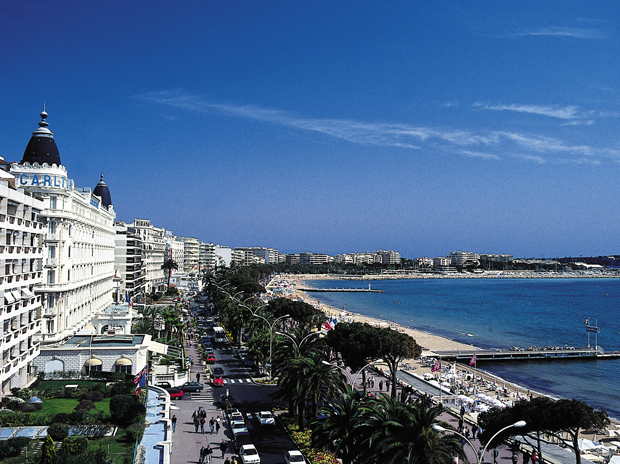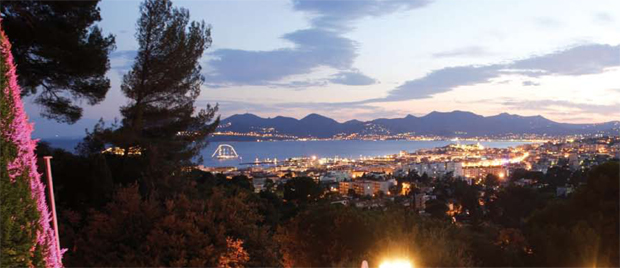

If luxury is that from which we derive pleasure, then it is impossible to exhaust its possibilities. Almost nowhere more than on Boulevard de la Croisette does the glamorous quest for luxury beget yet more luxury.
That Cannes’s name is derived from the Ligurian (the ancient dialect of the neighbouring region over the border in Italy) word meaning height or peak has, after a century and a half of glittering like a jewel on the crown of the Mediterranean, proven profoundly prophetic.
The world’s elite - aristocrats and royalty from every dynasty in the world, multi-billionaire heads of industry, the stars of stage, screen and stadium - look on the city as their personal playground. It is the lofty terrain on which they alight in pursuit of leisure. It is the nexus where the ever-ascending tangents of wealth, luxury, style, glamour and celebrity meet, following an ever more opulent and never-ending climb at whose summit it stands.
It was its year-round temperate climate, the azure seas glinting under the stunning Mediterranean blue sky, and a simple lifestyle fuelled by exquisite local delicacies that first drew the crème de la crème to this tiny thousand-year old Mediterranean fishing village.
To this day, Cannes is a functioning fishing port, where the timeless practicality of the local fishermen’s pointus, typical regional fishing craft, can be seen moored in the city’s harbours, bobbing proudly aside the otherworldly multi-million dollar yachts of the city’s wealthier sea-faring inhabitants.
It is this sunny and relaxed acceptance of extreme wealth and its trappings - that anything goes no matter how outlandishly luxurious - that enables Cannes to be one of the highlights of the classic chic of the French Riviera. The clack and thud of petanque and the mimosa’s vibrant yellow keep the pervasive and incandescent wealth grounded in a uniquely intimate and opulent ambience.
It has seen trends come and go - premiering, enduring, outliving, and even at times breaking fashions - all the while absorbing the powerful creative momentum of the high culture that washes up on its shores. This is the anointed ground that inspired Coco Chanel’s epitome of style, the scent No. 5, and saw Alain Delon and Brigitte Bardot burst onto the world’s screens and front pages with irrepressible beauty.
Seeking the ultimate luxury of winter sun, British aristocrats began making the annual pilgrimage to Cannes following Lord Brougham’s accidental discovery of the village in 1834. This sudden influx of free-spending and fantastically wealthy visitors spurred Cannes into a program of municipal improvements, including a railway connecting Cannes to Toulon, and most significantly the opening of a genuine sea-front thoroughfare befitting a coastal resort in the1860s.
Christened le chemin de la Croisette, from the Provencal name “crouseto” referring to a small cross sacred to the townspeople that had been erected in defiance of Saracen invaders in the Middle Ages - the name was changed to Boulevard de l’Impératrice” and returned to its original one in 1971 - it grew with the burgeoning resort town and within twenty years La Croisette had its own artificial beach and had been extended so that it traced the elegant curve of the shoreline from one side of the bay to the other. It had also added the now trademark colonnades of towering palm trees and the pretty benches lining the avenue which they shade.
As fame spread across the intricate web of European royal familial connections, the Russian court of Tsar Nicholas II soon descended on Cannes, led by the Tsar’s brother Grand Duke Michael of Russia, who inaugurated the Cannes-Mandelieu golf course - the first in the region and a prestige course to this day. This has now come full circle as the Russian economic powerhouse fuels its flourishing new elite’s quest for the finer things in life, a road which ultimately ends in the Côte d´Azur.
This demand for Cannes’ simple natural pleasures and its popularity spilled out into the wider European aristocracy and beyond; before the century was out it had become the holiday destination for the cream of European society. Since as early as 1859, Cannes has played host to what became the Régates Royales, which still attracts the world’s finest marine craft and wealthiest skippers.
In turn the quest for luxury gave birth to its own ever more opulent requirements. An almost constant evolution has taken place on La Croisette ever since, with the 1902 completion of the Albert-Edouard jetty and the legendary Casino Municipal five years later.
This cycle went into curlicued overdrive with the advent of the Belle Époque and the construction of the truly iconic art deco palace hotels of the 1920s, such as the Gallia Palace and the Carlton. These rightfully exalted temples to one of art’s greatest epochs can be seen as showcasing this radical movement, which re-imagined the building as organism, in the most fitting setting imaginable.
A palpable sense of abandon accompanies the rich at play. As they toy with the finest of all things, a sense of value is diminished and all that remains is the intoxicating thrill of hedonistic consumption. Nowhere is this more keenly felt than at the green baize of the casino and La Croisette has boasted some of the most spectacular gambling houses for some of the most spectacular gamblers in history.
There is not a royal family that did not have its kingly fortunes stacked against those of the Municipal Casino, by such regal players as Europe’s princes, Indian maharajahs, Arabian emirs, and even Vietnam’s last emperor. Established on La Croisette in 1907, this classic Belle Époque building became a legend in the annals of society nightlife, featuring show-stopping performances from French stage icons such as Maurice Chevalier, Mistinguett and a young Edith Piaf.
It was to this now world famous playground for the world’s most exclusive club, those truly at the pinnacle of high society, that the first truly global art form arrived. Cinema landed on La Croisette in 1938. Cannes was the benchmark of international sun-kissed glamour and therefore the perfect harbour in which cinema could lie in stately repose, reflect on its achievements and anticipate the new heights to which it would soar.
The Cannes International Film Festival did not really take hold of the international imagination until the year after. Under the presidency of Louis Lumière, the first official selection featured, amongst many now-legendary movies, “The Four Feathers” and “The Wizard of Oz”, and an incredible cast of the silver screen’s gods and goddesses, such as Tyrone Power, Norma Shearer, Gary Cooper, and George Raft.
The festival recovered from the bloody hiatus of the Second World War in 1948. It was staged in the Municipal Casino until the completion of the majestic Palais des Festivals, whose modern incarnation - completed in 1982 and currently undergoing a process of renewal - now ushers a galaxy of stars up its famous steps. It is this travelling celestial circus, the cosmos of stars who arrive year on year to promote their film, declare their commitment to cinema, and to bask in the limelight. Being seen to be being stars, these aristocrats of the box office hold the world’s attention captive for twelve glittering days in May, attending glittering receptions, screenings and awards.
The film festival does, therefore, bring with it a whole new level of glamour and its trappings - these are devotees to excesses of modern luxury about which many of the noble visitors of antiquity could only dream. To the already potent allure of luxury and wealth that Cannes already exudes they add fantasy; that magic dust caught in the projector beam.
In modern times, La Croisette seems cater to almost every luxury whim that could occur to a pampered imagination, boasting an array of classic palace hotels, such as the Majestic, the Martinez and the aforementioned Carlton, which have sprung up along this hallowed avenue since the heady days of the Belle Époque. These are now being joined by more contemporary takes on star-worthy luxury, such as the Palais Stéphanie and the 1835 White Hotel.
An extraordinary selection of fine cuisine is offered by all the major Cannes hotels, such as Christian Sinicropi’s two Michelin-starred restaurant at the Hôtel Martinez, Palme d´Or, which has been revered as one France’s finest eatery for twenty years. Considering the exquisite blends that nearly two hundred years of cultural refinement have produced in Cannes, fusion is a buzzword in its cuisine, such as that found at the beaches 3.14 Plage and Zplage.
A hallmark of glamour and luxury is the facility with which more can be obtained, and La Croisette affords visitors a panoply of the finest luxury boutiques on the face of the planet, catering to some of the most discerning shoppers on the planet. Naturally, it features such couture and joaillerie heavyweights as Chanel, Boucheron, Dior, Ferré, Bvlgari, Christian Lacroix, Fendi, Breguet, Hermès, Zegna, Salvatore Ferragamo, Gucci, Cartier and Chopard - who did Palme d´Or last redesign in 1977. As well, a new shopping center, 65, La Croisette - located next to Hôtel Martinez - hosts other world renown retail boutiques like Jimmy Choo, Balenciaga, Burberry and Yves Saint-Laurent.
Of course, a stay in one of Cannes’ splendid hotels leads to the next opulent step - a permanent residence. Neighbourhoods such as the Croix des Gardes, where the English aristocrats made their home all those years ago, and the chemin de la Californie - now avenue Albert 1er - have historically been the home of some of the city’s finest examples of classic Belle Époque architecture and to some of Cannes most dazzlingly wealthy residents. World famous examples include Villa Eléonore-Louise and the Villa Victoria. This remains the case today, with the Californie being known locally as Billionaire’s Hill and boasting properties worth tens of millions of Euros and the starriest of celebrity owners.
Like these timeless pieces of living and breathing architectural history, La Croisette can be seen as the theatre on which this gilded cycle has been played and re-played. A product of its own magnetic natural beauty, it has draped elite generation after elite generation around its shoulders and shone ever-more brilliantly.
Cannes is a most modern citadel constructed on a series of ever more ambitious demonstrations of the human desire to stretch for what is forever and luxuriously beyond our grasp. A fact of which the French have innate and intimate knowledge:
“It is impossible to overdo luxury.” French proverb.
- Benjamin Stewart
Boulevard de la Croisette
Address: Cannes, 06400
Website: www.palaisdesfestivals.com
Photo Credit: © Palais des festivals et des congrès de Cannes
That Cannes’s name is derived from the Ligurian (the ancient dialect of the neighbouring region over the border in Italy) word meaning height or peak has, after a century and a half of glittering like a jewel on the crown of the Mediterranean, proven profoundly prophetic.
The world’s elite - aristocrats and royalty from every dynasty in the world, multi-billionaire heads of industry, the stars of stage, screen and stadium - look on the city as their personal playground. It is the lofty terrain on which they alight in pursuit of leisure. It is the nexus where the ever-ascending tangents of wealth, luxury, style, glamour and celebrity meet, following an ever more opulent and never-ending climb at whose summit it stands.
It was its year-round temperate climate, the azure seas glinting under the stunning Mediterranean blue sky, and a simple lifestyle fuelled by exquisite local delicacies that first drew the crème de la crème to this tiny thousand-year old Mediterranean fishing village.
To this day, Cannes is a functioning fishing port, where the timeless practicality of the local fishermen’s pointus, typical regional fishing craft, can be seen moored in the city’s harbours, bobbing proudly aside the otherworldly multi-million dollar yachts of the city’s wealthier sea-faring inhabitants.
It is this sunny and relaxed acceptance of extreme wealth and its trappings - that anything goes no matter how outlandishly luxurious - that enables Cannes to be one of the highlights of the classic chic of the French Riviera. The clack and thud of petanque and the mimosa’s vibrant yellow keep the pervasive and incandescent wealth grounded in a uniquely intimate and opulent ambience.
It has seen trends come and go - premiering, enduring, outliving, and even at times breaking fashions - all the while absorbing the powerful creative momentum of the high culture that washes up on its shores. This is the anointed ground that inspired Coco Chanel’s epitome of style, the scent No. 5, and saw Alain Delon and Brigitte Bardot burst onto the world’s screens and front pages with irrepressible beauty.
Seeking the ultimate luxury of winter sun, British aristocrats began making the annual pilgrimage to Cannes following Lord Brougham’s accidental discovery of the village in 1834. This sudden influx of free-spending and fantastically wealthy visitors spurred Cannes into a program of municipal improvements, including a railway connecting Cannes to Toulon, and most significantly the opening of a genuine sea-front thoroughfare befitting a coastal resort in the1860s.
Christened le chemin de la Croisette, from the Provencal name “crouseto” referring to a small cross sacred to the townspeople that had been erected in defiance of Saracen invaders in the Middle Ages - the name was changed to Boulevard de l’Impératrice” and returned to its original one in 1971 - it grew with the burgeoning resort town and within twenty years La Croisette had its own artificial beach and had been extended so that it traced the elegant curve of the shoreline from one side of the bay to the other. It had also added the now trademark colonnades of towering palm trees and the pretty benches lining the avenue which they shade.
As fame spread across the intricate web of European royal familial connections, the Russian court of Tsar Nicholas II soon descended on Cannes, led by the Tsar’s brother Grand Duke Michael of Russia, who inaugurated the Cannes-Mandelieu golf course - the first in the region and a prestige course to this day. This has now come full circle as the Russian economic powerhouse fuels its flourishing new elite’s quest for the finer things in life, a road which ultimately ends in the Côte d´Azur.
This demand for Cannes’ simple natural pleasures and its popularity spilled out into the wider European aristocracy and beyond; before the century was out it had become the holiday destination for the cream of European society. Since as early as 1859, Cannes has played host to what became the Régates Royales, which still attracts the world’s finest marine craft and wealthiest skippers.
In turn the quest for luxury gave birth to its own ever more opulent requirements. An almost constant evolution has taken place on La Croisette ever since, with the 1902 completion of the Albert-Edouard jetty and the legendary Casino Municipal five years later.
This cycle went into curlicued overdrive with the advent of the Belle Époque and the construction of the truly iconic art deco palace hotels of the 1920s, such as the Gallia Palace and the Carlton. These rightfully exalted temples to one of art’s greatest epochs can be seen as showcasing this radical movement, which re-imagined the building as organism, in the most fitting setting imaginable.
A palpable sense of abandon accompanies the rich at play. As they toy with the finest of all things, a sense of value is diminished and all that remains is the intoxicating thrill of hedonistic consumption. Nowhere is this more keenly felt than at the green baize of the casino and La Croisette has boasted some of the most spectacular gambling houses for some of the most spectacular gamblers in history.
There is not a royal family that did not have its kingly fortunes stacked against those of the Municipal Casino, by such regal players as Europe’s princes, Indian maharajahs, Arabian emirs, and even Vietnam’s last emperor. Established on La Croisette in 1907, this classic Belle Époque building became a legend in the annals of society nightlife, featuring show-stopping performances from French stage icons such as Maurice Chevalier, Mistinguett and a young Edith Piaf.
It was to this now world famous playground for the world’s most exclusive club, those truly at the pinnacle of high society, that the first truly global art form arrived. Cinema landed on La Croisette in 1938. Cannes was the benchmark of international sun-kissed glamour and therefore the perfect harbour in which cinema could lie in stately repose, reflect on its achievements and anticipate the new heights to which it would soar.
The Cannes International Film Festival did not really take hold of the international imagination until the year after. Under the presidency of Louis Lumière, the first official selection featured, amongst many now-legendary movies, “The Four Feathers” and “The Wizard of Oz”, and an incredible cast of the silver screen’s gods and goddesses, such as Tyrone Power, Norma Shearer, Gary Cooper, and George Raft.
The festival recovered from the bloody hiatus of the Second World War in 1948. It was staged in the Municipal Casino until the completion of the majestic Palais des Festivals, whose modern incarnation - completed in 1982 and currently undergoing a process of renewal - now ushers a galaxy of stars up its famous steps. It is this travelling celestial circus, the cosmos of stars who arrive year on year to promote their film, declare their commitment to cinema, and to bask in the limelight. Being seen to be being stars, these aristocrats of the box office hold the world’s attention captive for twelve glittering days in May, attending glittering receptions, screenings and awards.
The film festival does, therefore, bring with it a whole new level of glamour and its trappings - these are devotees to excesses of modern luxury about which many of the noble visitors of antiquity could only dream. To the already potent allure of luxury and wealth that Cannes already exudes they add fantasy; that magic dust caught in the projector beam.
In modern times, La Croisette seems cater to almost every luxury whim that could occur to a pampered imagination, boasting an array of classic palace hotels, such as the Majestic, the Martinez and the aforementioned Carlton, which have sprung up along this hallowed avenue since the heady days of the Belle Époque. These are now being joined by more contemporary takes on star-worthy luxury, such as the Palais Stéphanie and the 1835 White Hotel.
An extraordinary selection of fine cuisine is offered by all the major Cannes hotels, such as Christian Sinicropi’s two Michelin-starred restaurant at the Hôtel Martinez, Palme d´Or, which has been revered as one France’s finest eatery for twenty years. Considering the exquisite blends that nearly two hundred years of cultural refinement have produced in Cannes, fusion is a buzzword in its cuisine, such as that found at the beaches 3.14 Plage and Zplage.
A hallmark of glamour and luxury is the facility with which more can be obtained, and La Croisette affords visitors a panoply of the finest luxury boutiques on the face of the planet, catering to some of the most discerning shoppers on the planet. Naturally, it features such couture and joaillerie heavyweights as Chanel, Boucheron, Dior, Ferré, Bvlgari, Christian Lacroix, Fendi, Breguet, Hermès, Zegna, Salvatore Ferragamo, Gucci, Cartier and Chopard - who did Palme d´Or last redesign in 1977. As well, a new shopping center, 65, La Croisette - located next to Hôtel Martinez - hosts other world renown retail boutiques like Jimmy Choo, Balenciaga, Burberry and Yves Saint-Laurent.
Of course, a stay in one of Cannes’ splendid hotels leads to the next opulent step - a permanent residence. Neighbourhoods such as the Croix des Gardes, where the English aristocrats made their home all those years ago, and the chemin de la Californie - now avenue Albert 1er - have historically been the home of some of the city’s finest examples of classic Belle Époque architecture and to some of Cannes most dazzlingly wealthy residents. World famous examples include Villa Eléonore-Louise and the Villa Victoria. This remains the case today, with the Californie being known locally as Billionaire’s Hill and boasting properties worth tens of millions of Euros and the starriest of celebrity owners.
Like these timeless pieces of living and breathing architectural history, La Croisette can be seen as the theatre on which this gilded cycle has been played and re-played. A product of its own magnetic natural beauty, it has draped elite generation after elite generation around its shoulders and shone ever-more brilliantly.
Cannes is a most modern citadel constructed on a series of ever more ambitious demonstrations of the human desire to stretch for what is forever and luxuriously beyond our grasp. A fact of which the French have innate and intimate knowledge:
“It is impossible to overdo luxury.” French proverb.
- Benjamin Stewart
Boulevard de la Croisette
Address: Cannes, 06400
Website: www.palaisdesfestivals.com
Photo Credit: © Palais des festivals et des congrès de Cannes
La Croisette






